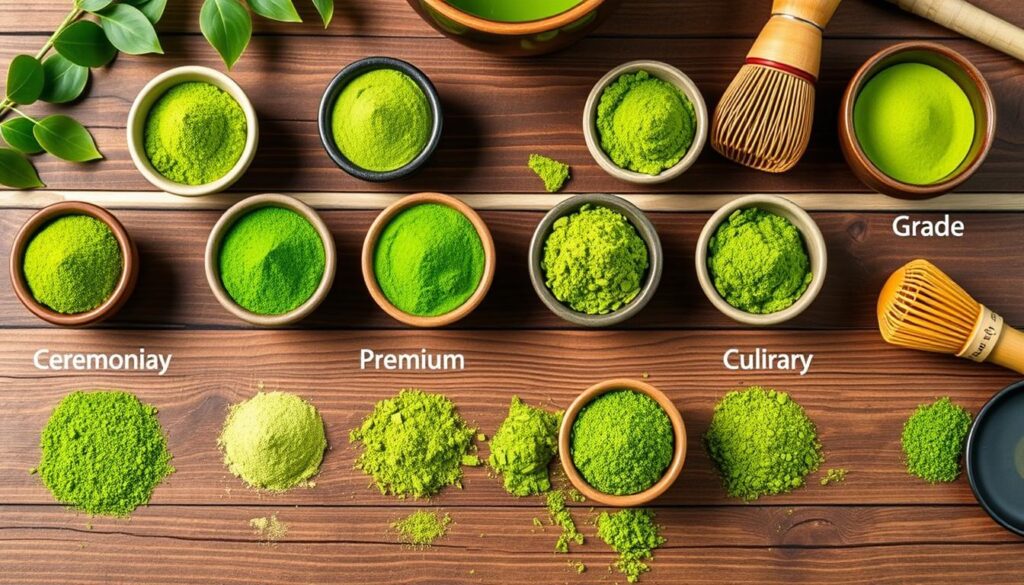Exploring matcha tea is an exciting adventure for those who love drinks and care about health. This green tea powder comes from Japan and is loved worldwide. It offers special tastes and health perks. Knowing about matcha grades helps you pick the best for your drinks and cooking.
Matcha is more than just green tea powder. It’s a special Japanese tea with its own unique traits. Whether for ceremonies or cooking, each matcha grade has its own flavor and benefits.
Key Takeaways
- Matcha tea comes in multiple grades with different uses
- Quality affects flavor, color, and potential health benefits
- Choosing the right grade depends on your specific purpose
- Japanese tea traditions deeply influence matcha production
- Proper storage is essential for maintaining matcha quality
Understanding the Ancient Origins of Matcha Tea
Matcha tea’s story is deeply tied to Japanese culture. It combines spiritual practices with agricultural innovations. This green tea evolved from a monastic drink to a worldwide favorite.
Matcha’s history starts in Japan’s Zen Buddhist monasteries. Monks found a deep link between tea and meditation. The art of growing matcha became a spiritual practice, showing mindfulness and detail.
Traditional Japanese Tea Ceremony: A Spiritual Ritual
The Japanese tea ceremony, or chanoyu, is more than making tea. It’s a complex cultural ritual that turns tea into a meditative experience. Key parts of this ceremony include:
- Precise preparation techniques
- Ritualistic movements
- Aesthetic presentation
- Spiritual contemplation
The Evolution of Matcha Processing
Matcha processing has changed a lot since it started. The old ways, created by Zen monks, still guide today’s methods.
| Era | Processing Technique | Key Characteristics |
|---|---|---|
| Medieval Period | Hand-ground stone mills | Limited production, ceremonial use |
| Modern Era | Mechanized grinding | Large-scale production, global distribution |
From Zen Temples to Modern Cafes
“Tea is quiet and our thirst for tea is never far from our craving for beauty.” – James Norwood Pratt
Matcha’s journey from Zen temples to modern cafes shows its cultural flexibility. What started as a spiritual ritual has become a global wellness trend. It connects ancient traditions with today’s lifestyle.
What Makes Matcha Different from Regular Green Tea
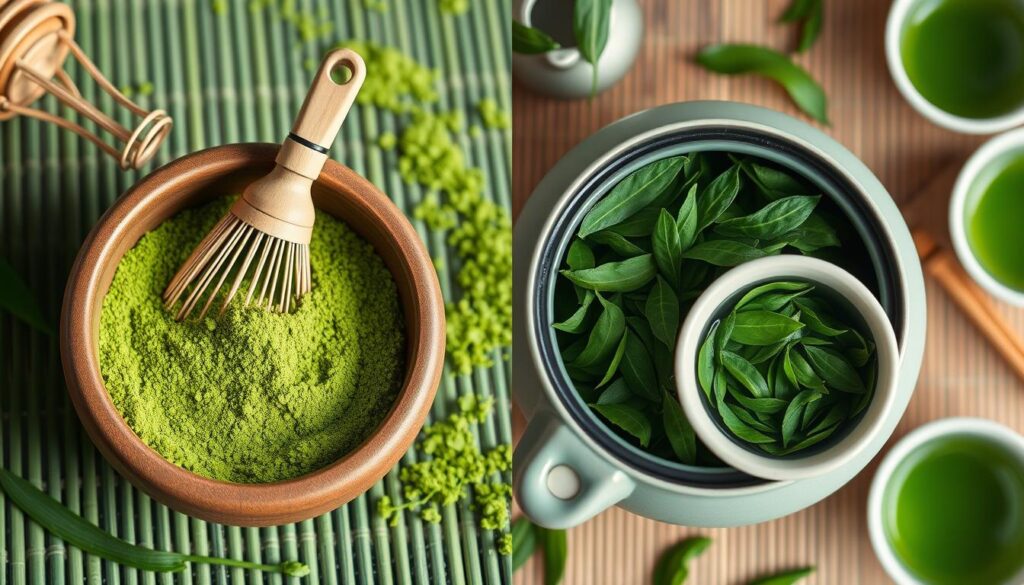
Matcha and green tea might look similar at first, but they are quite different. Green tea is made by steeping leaves and throwing them away. But matcha is special because you drink the whole leaf, ground into a fine powder.
Matcha and regular green tea differ in more ways than just how they’re made. Matcha is packed with more nutrients, including antioxidants and a special amino acid called L-theanine.
- Cultivation: Matcha tea plants are shade-grown, increasing chlorophyll and nutrient content
- Processing: Entire leaves are stone-ground into a vibrant green powder
- Consumption: Matcha is whisked and consumed whole, unlike steeped green tea
“Drinking matcha is like consuming an entire tea leaf, maximizing its health benefits” – Traditional Japanese Tea Master
Looking at the health benefits of matcha and green tea shows matcha’s big advantages. Matcha has up to 137 times more antioxidants than regular green tea. This makes it a strong nutritional boost.
| Characteristic | Matcha | Regular Green Tea |
|---|---|---|
| Antioxidant Levels | Very High | Moderate |
| L-theanine Content | Elevated | Low |
| Caffeine | Sustained Release | Quick Spike |
The L-theanine in matcha offers a special benefit. It helps you relax without feeling sleepy and boosts your mental focus. This makes matcha a great choice for those looking for wellness and better brain function.
The Essential Components of High-Quality Matcha
Finding top-notch matcha takes a sharp eye and a sensitive taste. Tea experts know matcha is more than a drink—it’s a craft that needs careful checking.
Checking matcha quality means looking at several key traits. These traits show its real worth.
Color: The Green Indicator of Quality
Great matcha has a bright, deep green color. This color shows it’s full of nutrients. The color should be even and not yellow or brown, which means it’s not fresh or was made wrong.
- Bright, vivid green means high-quality matcha
- Dull or faded colors mean lower-quality tea
- Even color shows it was grown well
Texture: The Silky Smooth Experience
Top matcha feels very fine and smooth. When you rub it between your fingers, it should feel like soft talcum powder. It should not be grainy or clumpy.
“The texture of matcha is as important as its flavor—it should whisper quality with every touch.”
Flavor Profile: A Symphony of Taste
Real matcha taste is complex. It’s umami, a bit sweet, and has a clean, grassy taste. The flavor should be rich but balanced, without being bitter.
- Initial umami notes
- Subtle sweetness
- Clean, lingering finish
Knowing these key points helps tea lovers pick matcha for a great taste experience.
Matcha 101: Choosing the Right Grade for Your Drinks
Choosing the right matcha grade can make your drinks amazing. It’s important to know how to pick the best matcha powder for your drinks. This way, you can make delicious and authentic drinks that truly capture the essence of green tea.
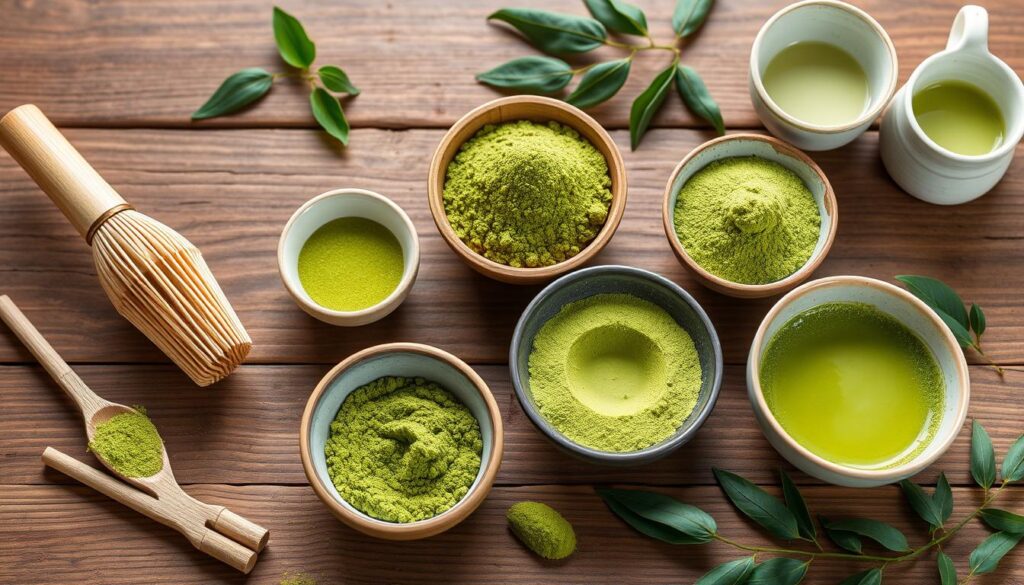
When looking at matcha grades for drinks, you’ll find three main types:
- Ceremonial Grade: The highest quality, perfect for traditional tea making
- Premium Grade: Great for drinking and light cooking
- Culinary Grade: Best for smoothies, baking, and mixed drinks
“The right matcha grade can elevate your drink from simple to sublime.” – Tea Master’s Wisdom
Each grade has its own special qualities for your drinks. Ceremonial grade has a smooth, delicate taste, perfect for traditional tea. Premium grade is versatile for many drink types. Culinary grade is great for complex drinks.
Your choice of matcha powder depends on what you want to make. For a pure tea taste, go for ceremonial grade. For a matcha latte, premium or culinary grades are better. For smoothies or cocktails, culinary grade adds bold flavor and color.
Remember, the color, smell, and texture of matcha tell you its quality. A bright green color, fine powder, and a rich umami scent mean you have a top-notch product. It’s ready to make your drinks special.
Ceremonial Grade Matcha: The Premium Choice
Exploring the best matcha starts with ceremonial grade. This top-notch tea is the highest quality in green tea. It shows the rich tradition of Japanese tea making.
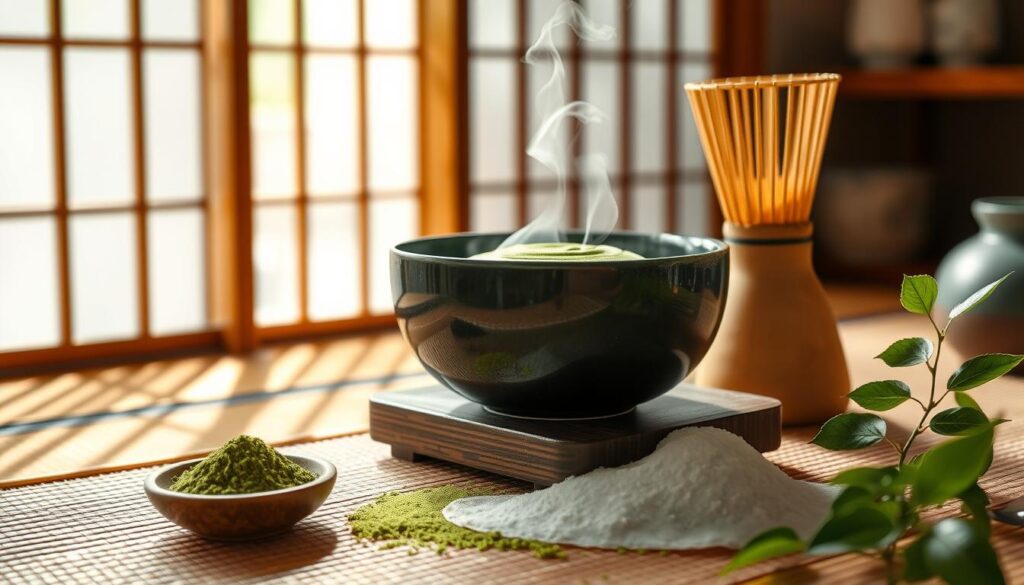
Matcha is special because of its careful making and unique taste. The matcha tea ceremony requires perfection in every step.
Characteristics and Best Uses
Ceremonial grade matcha has unique features:
- Vibrant emerald green color
- Ultra-fine, silky powder texture
- Delicate, smooth flavor with minimal bitterness
- Exceptional nutritional density
“True ceremonial grade matcha is an art form, not just a beverage.” – Japanese Tea Master
Price Points and Value Considerations
Buying ceremonial grade matcha means you value quality and tradition. The cost shows its high-quality making and rare production.
| Grade | Price Range | Recommended Use |
|---|---|---|
| Ceremonial Grade | $30-$60 per 30g | Pure drinking, traditional tea ceremony |
| Premium Grade | $20-$40 per 30g | Drinking and light culinary uses |
| Culinary Grade | $10-$25 per 30g | Baking, smoothies, cooking |
For those who love matcha, ceremonial grade is the best. Its unmatched quality connects you deeply to Japanese tea culture.
Culinary Grade Matcha: Perfect for Recipes
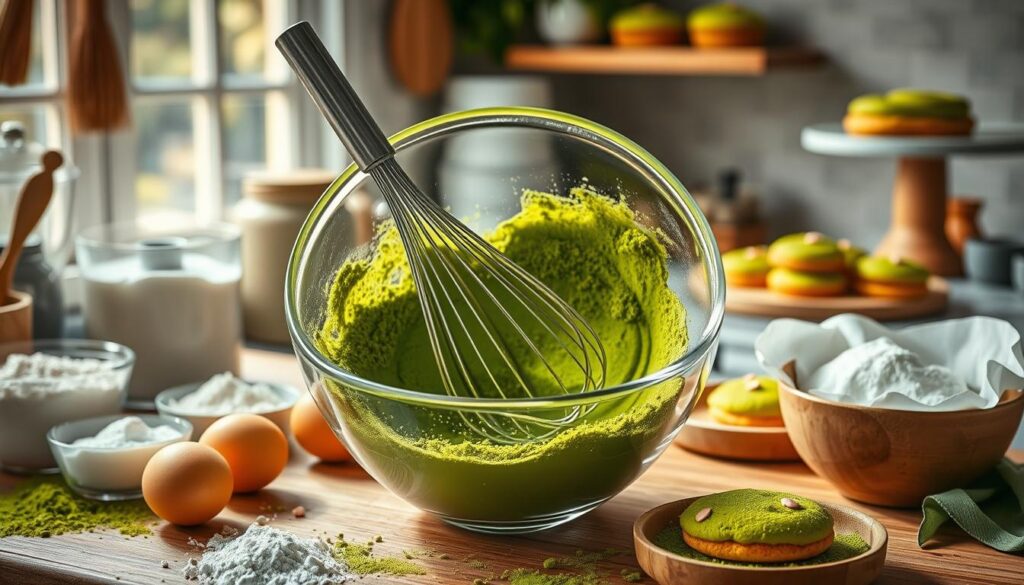
Culinary grade matcha is a versatile choice for many recipes. It’s not as delicate as ceremonial matcha. Instead, it has a strong flavor that’s great for both sweet and savory dishes.
Chefs and home cooks love culinary grade matcha for its unique taste. Its slightly bitter flavor is perfect for baking, smoothies, and trying new recipes.
- Ideal for baked goods like cookies and cakes
- Perfect for smoothies and breakfast recipes
- Great for marinades and savory dish enhancements
- More affordable than ceremonial grade matcha
“Culinary grade matcha transforms ordinary recipes into extraordinary culinary experiences.” – Matcha Culinary Expert
Exploring matcha in cooking opens up endless possibilities. You can make green tea ice cream or matcha pasta sauces. The secret is knowing how its strong flavor works with other ingredients.
Both professional kitchens and home cooks use culinary grade matcha. It adds depth, color, and nutrition to many dishes. It’s perfect for quick breakfast smoothies or elaborate desserts, always delivering great results.
Premium Grade Matcha: The Middle Ground Option
Exploring matcha can be tricky, but premium grade matcha is a great middle ground. It’s a mix of quality and price, perfect for those who want the best of both worlds. This option is great for making different types of matcha drinks.
Premium grade matcha is perfect for those looking for value without losing quality. It has a strong flavor that’s great for many uses. You can enjoy it in traditional tea ceremonies or in modern drinks.
Versatility in Different Preparations
Premium grade matcha is versatile and works well in many ways:
- Smooth and rich matcha for lattes
- Blending into smoothies and protein shakes
- Baking and cooking applications
- Traditional whisked tea preparation
Cost-Benefit Analysis
When you choose premium grade matcha, you get:
- More affordable pricing than ceremonial grade
- Higher quality than standard culinary matcha
- Consistent flavor and color
- Versatile usage across different recipes
“Premium grade matcha represents the perfect intersection of quality and practicality for discerning tea enthusiasts.”
Selecting premium grade matcha ensures you get excellent taste and flexibility without breaking the bank.
Storage and Preservation Tips for Different Matcha Grades
Keeping matcha fresh is all about the right storage. This green tea powder is very delicate. It needs special care to keep its taste and health benefits.
Here are the main things to keep in mind for storing matcha:
- Protect from light
- Stay away from moisture and humidity
- Keep it cool
- Use containers that seal tight
The best containers for matcha are dark, airtight tins or ceramic jars with tight lids. Ceramic is great because it blocks light and keeps temperatures steady
“Proper matcha storage is an art that preserves the essence of this ancient beverage.” – Tea Preservation Expert
Storing matcha in the fridge can help it last longer. But, you must seal it well. Let it come to room temperature before opening to avoid moisture.
| Matcha Grade | Recommended Storage Duration | Storage Conditions |
|---|---|---|
| Ceremonial Grade | 1-2 months | Cool, dark place |
| Culinary Grade | 3-4 months | Refrigerated |
Pro tip: Buy matcha in small amounts to keep it fresh and flavorful.
Using these storage tips, matcha lovers can keep their green tea powder fresh and delicious for longer.
Common Mistakes When Selecting Matcha Grades
Exploring matcha can be tough for both new and seasoned tea lovers. It’s key to know about matcha quality control to buy well and enjoy a real matcha experience.
Many people make big mistakes when picking matcha. These errors can really change how you enjoy your tea. It’s vital to know these mistakes to love authentic matcha.
Quality Assessment Guidelines
There are important things to look at when checking matcha quality:
- Color: Vibrant green means top-notch matcha. If it’s dull or yellowish, it’s likely low quality or old.
- Texture: The best matcha is very fine and smooth, like baby powder.
- Aroma: Good matcha smells rich and grassy with a hint of sweetness.
Authenticity Verification Methods
To avoid fake matcha, you need to be careful:
- Look for origin documents from trusted Japanese tea makers.
- Make sure it has third-party quality checks.
- Ask for all the details about how it was made.
“True matcha is an art form, not just a beverage” – Traditional Japanese Tea Master
When buying matcha, look into places like Uji in Kyoto. They’re famous for the best matcha. Always choose clear sources and strict quality checks.
Where to Buy Different Grades of Matcha
Finding high-quality matcha means knowing the right places to look. Buying matcha online is now easy, with many options for tea lovers and health fans.
- Specialized Online Matcha Specialty Stores
- Direct Japanese Importers
- Gourmet Tea Websites
- Health Food Retailers
Online platforms have big benefits for matcha shoppers:
| Retailer Type | Pros | Recommended Grade |
|---|---|---|
| Japanese Specialty Stores | Authentic sourcing, direct imports | Ceremonial Grade |
| Organic Health Retailers | Certified quality, transparent sourcing | Premium/Culinary Grade |
| Gourmet Tea Websites | Wide selection, detailed descriptions | All Grades |
“Quality matcha is an art, not just a purchase.” – Japanese Tea Master
When shopping online, make sure to:
- Check origin certification
- Look at the harvest date
- See storage tips
- Read customer reviews
Pro tip: Local tea shops and Japanese markets are great for premium matcha. They offer personal advice and let you check the product right away.
Conclusion
Exploring matcha means learning about its different grades and special qualities. A good matcha guide helps tea lovers improve their experience. It shows the differences between ceremonial, premium, and culinary grades.
Matcha quality is more than just taste. It’s about honoring Japan’s tea-making tradition. Knowing the differences lets you pick the right matcha for you. Whether for a tea ceremony or new recipes, the right knowledge is crucial.
Your matcha adventure is all about trying new things. Start by tasting different grades and seeing how they work in different ways. High-quality matcha can make any drink or dish special, turning everyday moments into something special.
Being a matcha expert means always being curious and learning more. With time and an open mind, you’ll know exactly which matcha to choose. It will match your taste and cooking dreams perfectly.
FAQ
What is the difference between ceremonial grade and culinary grade matcha?
Ceremonial grade matcha is top-notch, made from young tea leaves. It has a delicate taste, perfect for tea ceremonies. Culinary grade matcha is cheaper, tastes stronger, and is great for cooking and making lattes.
How do I know if I’m buying authentic Japanese matcha?
Look for matcha from Japan, especially Uji, Kyoto. This area is famous for matcha. Check for certifications and clear information on the packaging.
What health benefits does matcha offer?
Matcha is full of antioxidants, like EGCG. It gives a steady energy boost and supports metabolism. It also improves mental focus and may boost your immune system.
How should I store my matcha to maintain its freshness?
Keep matcha in a sealed container, away from light and heat. Refrigeration helps keep it fresh. Use it within 4-6 weeks after opening for the best taste and health benefits.
Can I make matcha with any type of milk?
Yes! You can use any milk for matcha lattes. Dairy, almond, oat, or plant-based milks change the flavor and texture.
Is matcha suitable for people with caffeine sensitivity?
Matcha has caffeine, but it’s released more slowly than coffee. This is thanks to L-theanine. Still, those very sensitive to caffeine should talk to a doctor.
What’s the best way to prepare traditional matcha tea?
Use ceremonial grade matcha. Sift 1-2 teaspoons into a bowl. Add hot water around 175°F. Whisk in a “W” motion until it’s frothy and smooth.
How can I tell if my matcha is high-quality?
Good matcha is bright green, fine, and has a sweet aroma. It tastes smooth and umami. Avoid dull, brown, or coarse matcha.
Share this post: on Twitter on Facebook

